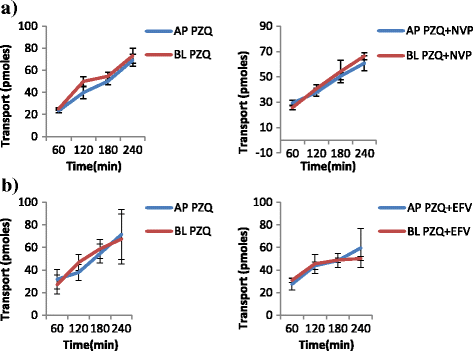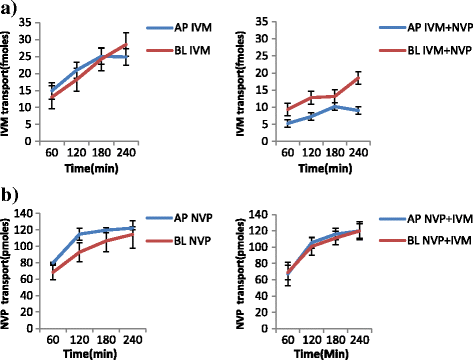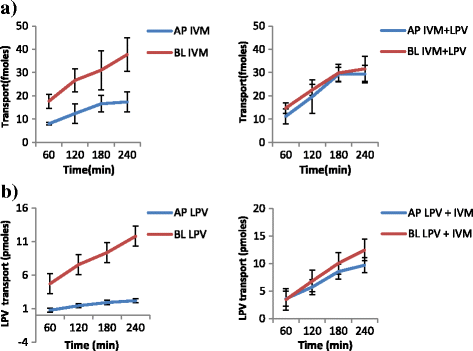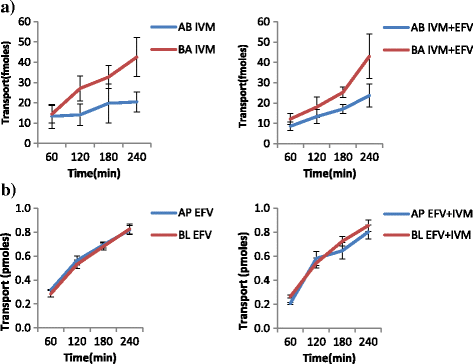Drug-transporter mediated interactions between anthelminthic and antiretroviral drugs across the Caco-2 cell monolayers
- PMID: 28468637
- PMCID: PMC5415745
- DOI: 10.1186/s40360-017-0129-6
Drug-transporter mediated interactions between anthelminthic and antiretroviral drugs across the Caco-2 cell monolayers
Abstract
Background: Drug interactions between antiretroviral drugs (ARVs) and anthelminthic drugs, ivermectin (IVM) and praziquantel (PZQ) were assessed by investigating their permeation through the Caco-2 cell monolayers in a transwell. The impact of anthelminthics on the transport of ARVs was determined by assessing the apical to basolateral (AP → BL) [passive] and basolateral to apical (BL → AP) [efflux] directions alone, and in presence of an anthelminthic. The reverse was conducted for the assessment of the influence of ARVs on anthelminthics.
Methods: Samples from the AP and BL compartments were taken at 60, 120, 180 and 240 min and quantified either by HPLC or radiolabeled assay using a liquid scintillating counter for the respective drugs. Transepithelial resistance (TEER) was used to assess the integrity of the monolayers. The amount of compound transported per second (apparent permeability, Papp) was calculated for both AP to BL (PappAtoB), and BL to AP (PappBtoA) movements. Samples collected after 60 min were used to determine the efflux ratio (ER), quotient of secretory permeability and absorptive permeability (PappBL-AP/PappAP-BL). The reverse, (PappAP-BL/PappBL-AP) constituted the uptake ratio. The impact of SQV, EFV and NVP on the transport of both IVM and PZQ were investigated. The effect of LPV on the transport of IVM was also determined. The influence of IVM on the transport of SQV, NVP, LPV and EFV; as well as the effect PZQ on the transport of SQV of was also investigated, and a two-tailed p value of <0.05 was considered significant.
Results: IVM significantly inhibited the efflux transport (BL → AP movement) of LPV (ER; 6.7 vs. 0.8, p = 0.0038) and SQV (ER; 3.1 vs. 1.2 p = 0.00328); and increased the efflux transport of EFV (ER; 0.7 vs. 0.9, p = 0.031) suggesting the possibility of drug transporter mediated interactions between the two drugs. NVP increased the efflux transport of IVM (ER; 0.8 vs. 1.8, p = 0.0094).
Conclusions: The study provides in vitro evidence of potential interactions between IVM, an anthelminthic drug with antiretroviral drugs; LPV, SQV, NVP and EFV. Further investigations should be conducted to investigate the possibility of in vivo interactions.
Keywords: Antiparasitic; Antiretroviral; Caco-2 cell monolayers; Drug interactions; Drug transport; Intestinal epithelium; TEER.
Figures







Similar articles
-
Transport characteristics of peptidomimetics. Effect of the pyrrolinone bioisostere on transport across Caco-2 cell monolayers.Pharm Res. 1998 May;15(5):719-25. doi: 10.1023/a:1011966918959. Pharm Res. 1998. PMID: 9619780
-
Carrier mechanisms involved in the transepithelial transport of bis(POM)-PMEA and its metabolites across Caco-2 monolayers.Pharm Res. 1998 Aug;15(8):1168-73. doi: 10.1023/a:1011923420719. Pharm Res. 1998. PMID: 9706045
-
Isolation and characterization of Caco-2 subclones expressing high levels of multidrug resistance protein efflux transporter.Pharm Res. 2003 Feb;20(2):161-8. doi: 10.1023/a:1022359300826. Pharm Res. 2003. PMID: 12636153
-
Interaction of ochratoxin A with human intestinal Caco-2 cells: possible implication of a multidrug resistance-associated protein (MRP2).Toxicol Lett. 2003 Apr 11;140-141:465-76. doi: 10.1016/s0378-4274(03)00043-2. Toxicol Lett. 2003. PMID: 12676495 Review.
-
Caco-2 cells, biopharmaceutics classification system (BCS) and biowaiver.Acta Medica (Hradec Kralove). 2011;54(1):3-8. Acta Medica (Hradec Kralove). 2011. PMID: 21542416 Review.
Cited by
-
The Use of Systemically Absorbed Drugs to Explore An In Vitro Bioequivalence Approach For Comparing Non-Systemically Absorbed Active Pharmaceutical Ingredients in Drug Products For Use in Dogs.Pharm Res. 2024 Sep;41(9):1797-1809. doi: 10.1007/s11095-024-03766-3. Epub 2024 Sep 9. Pharm Res. 2024. PMID: 39251485 Free PMC article.
-
Repurposing the drug, ivermectin, in COVID-19: toxicological points of view.Eur J Med Res. 2022 Feb 5;27(1):21. doi: 10.1186/s40001-022-00645-8. Eur J Med Res. 2022. PMID: 35123559 Free PMC article. Review.
-
Pharmacokinetics and antioxidant activity of dihydrocaffeic acid grafted chitosan nanomicelles loaded with chicoric acid in broilers.Poult Sci. 2024 Jul;103(7):103776. doi: 10.1016/j.psj.2024.103776. Epub 2024 Apr 16. Poult Sci. 2024. PMID: 38688136 Free PMC article.
-
Beneficial Pharmacokinetic Drug Interactions: A Tool to Improve the Bioavailability of Poorly Permeable Drugs.Pharmaceutics. 2018 Jul 26;10(3):106. doi: 10.3390/pharmaceutics10030106. Pharmaceutics. 2018. PMID: 30049988 Free PMC article. Review.
-
Absorption and Transport Characteristics and Mechanisms of Carnosic Acid.Biology (Basel). 2021 Dec 6;10(12):1278. doi: 10.3390/biology10121278. Biology (Basel). 2021. PMID: 34943193 Free PMC article.
References
-
- Seden K, Khoo S, Back D, Prevatt N, Lamorde M, Byakika-Kibwika P, Mayito J, Ryan M, Merry C. Drug-drug interactions between antiretrovirals and drugs used in the management of neglected tropical diseases: important considerations in the WHO 2020 Roadmap and London Declaration on Neglected Tropical Diseases. AIDS (London, England) 2013;27:675–-686. doi: 10.1097/QAD.0b013e32835ca9b4. - DOI - PubMed
Publication types
MeSH terms
Substances
LinkOut - more resources
Full Text Sources
Other Literature Sources

